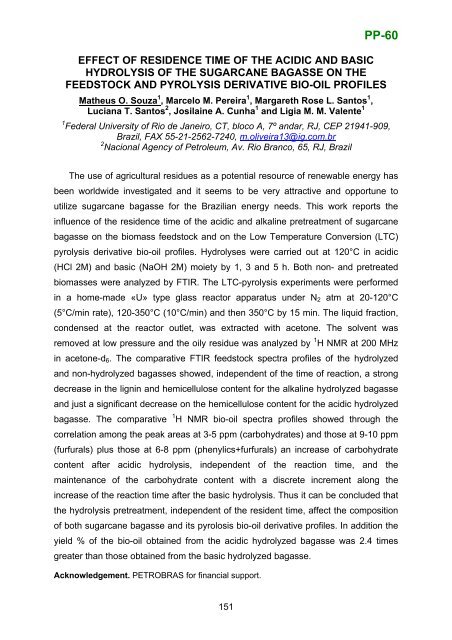Boreskov Institute of Catalysis SB RAS, Novosibirsk, Russia
Boreskov Institute of Catalysis SB RAS, Novosibirsk, Russia
Boreskov Institute of Catalysis SB RAS, Novosibirsk, Russia
- No tags were found...
You also want an ePaper? Increase the reach of your titles
YUMPU automatically turns print PDFs into web optimized ePapers that Google loves.
PP-60EFFECT OF RESIDENCE TIME OF THE ACIDIC AND BASICHYDROLYSIS OF THE SUGARCANE BAGASSE ON THEFEEDSTOCK AND PYROLYSIS DERIVATIVE BIO-OIL PROFILESMatheus O. Souza 1 , Marcelo M. Pereira 1 , Margareth Rose L. Santos 1 ,Luciana T. Santos 2 , Josilaine A. Cunha 1 and Ligia M. M. Valente 11 Federal University <strong>of</strong> Rio de Janeiro, CT, bloco A, 7º andar, RJ, CEP 21941-909,Brazil, FAX 55-21-2562-7240, m.oliveira13@ig.com.br2 Nacional Agency <strong>of</strong> Petroleum, Av. Rio Branco, 65, RJ, BrazilThe use <strong>of</strong> agricultural residues as a potential resource <strong>of</strong> renewable energy hasbeen worldwide investigated and it seems to be very attractive and opportune toutilize sugarcane bagasse for the Brazilian energy needs. This work reports theinfluence <strong>of</strong> the residence time <strong>of</strong> the acidic and alkaline pretreatment <strong>of</strong> sugarcanebagasse on the biomass feedstock and on the Low Temperature Conversion (LTC)pyrolysis derivative bio-oil pr<strong>of</strong>iles. Hydrolyses were carried out at 120°C in acidic(HCl 2M) and basic (NaOH 2M) moiety by 1, 3 and 5 h. Both non- and pretreatedbiomasses were analyzed by FTIR. The LTC-pyrolysis experiments were performedin a home-made «U» type glass reactor apparatus under N 2 atm at 20-120°C(5°C/min rate), 120-350°C (10°C/min) and then 350°C by 15 min. The liquid fraction,condensed at the reactor outlet, was extracted with acetone. The solvent wasremoved at low pressure and the oily residue was analyzed by 1 H NMR at 200 MHzin acetone-d 6 . The comparative FTIR feedstock spectra pr<strong>of</strong>iles <strong>of</strong> the hydrolyzedand non-hydrolyzed bagasses showed, independent <strong>of</strong> the time <strong>of</strong> reaction, a strongdecrease in the lignin and hemicellulose content for the alkaline hydrolyzed bagasseand just a significant decrease on the hemicellulose content for the acidic hydrolyzedbagasse. The comparative 1 H NMR bio-oil spectra pr<strong>of</strong>iles showed through thecorrelation among the peak areas at 3-5 ppm (carbohydrates) and those at 9-10 ppm(furfurals) plus those at 6-8 ppm (phenylics+furfurals) an increase <strong>of</strong> carbohydratecontent after acidic hydrolysis, independent <strong>of</strong> the reaction time, and themaintenance <strong>of</strong> the carbohydrate content with a discrete increment along theincrease <strong>of</strong> the reaction time after the basic hydrolysis. Thus it can be concluded thatthe hydrolysis pretreatment, independent <strong>of</strong> the resident time, affect the composition<strong>of</strong> both sugarcane bagasse and its pyrolosis bio-oil derivative pr<strong>of</strong>iles. In addition theyield % <strong>of</strong> the bio-oil obtained from the acidic hydrolyzed bagasse was 2.4 timesgreater than those obtained from the basic hydrolyzed bagasse.Acknowledgement. PETROB<strong>RAS</strong> for financial support.151
















